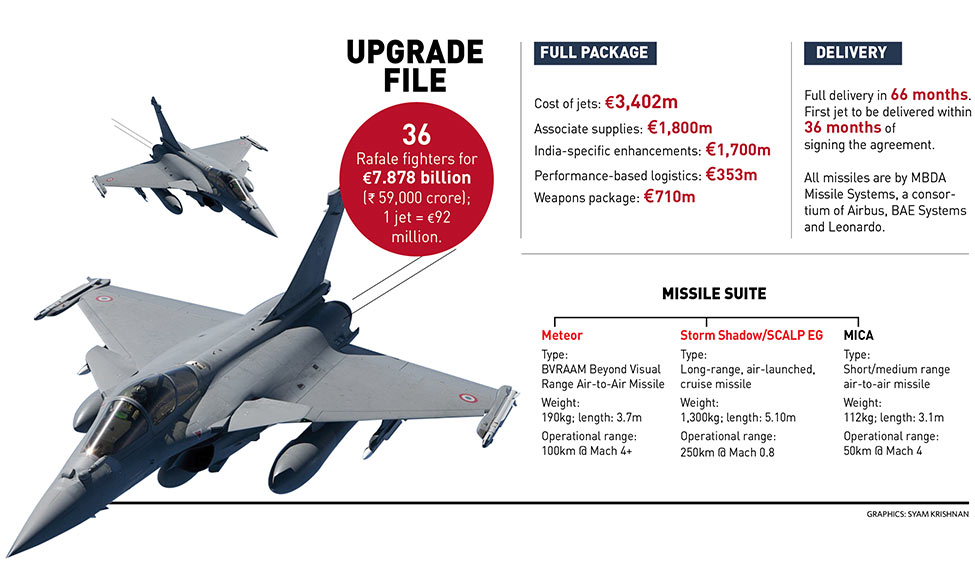The world’s fourth largest air force, which had 42 squadrons of fighter jets in 2002, will be down to 28 by 2020 and to 19 by 2042, if the government does not act fast. Currently, the Indian Air Force has 32 combat squadrons, each with 18 jets.
The IAF needs at least 10 more squadrons to effectively counter a two-front war. Against the IAF’s 550 combat aircraft, China has over 1,700 and Pakistan 450.
“We are now fighting over the issue of best price for fighter jets,” said former IAF chief A.Y. Tipnis. “But, we are not paying attention to what is happening in our neighbourhood—in China and Pakistan. The IAF has to be strengthened to save this country.” Even if all goes well with the Narendra Modi government’s deal for 36 Dassault Rafales, the first aircraft would reach India only by mid-2019 and rest over the next 30 months.
“Do not politicise the issue,” said Air Marshal (retd) M. Matheswaran, who was deputy chief of integrated defence staff and a key negotiator in the Manmohan Singh government’s efforts to buy 126 fighter jets. “IAF’s force structure is in a very critical stage. In 2004, when the IAF initiated the process of acquiring 126 aircraft, we needed them by 2008. But, nine years have been wasted, and we are nowhere close to getting the aircraft.”
Air Vice Marshal (retd) Manmohan Bahadur said two new squadrons were not enough. “The Rafale is a good and capable aircraft, and I would like the IAF to have more Rafale jets in its inventory,” he said. “Though we are getting 123 Tejas light combat aircraft, I have serious doubts over Hindustan Aeronautics Limited’s (HAL) ability to deliver in time. Moreover, we selected the Rafale after trials and due process. Rafale and Tejas are not in same class, in terms of capability and endurance. Tejas is also a high maintenance aircraft.”
It was in 2001, that the IAF told the defence ministry that it needed at least 126 medium multi-role combat aircraft (MMRCA). The National Democratic Alliance was in power, with A.B. Vajpayee as prime minister. George Fernandes was defence minister, except for a seven-month stint by Jaswant Singh.
In 2004, the United Progressive Alliance came to power with Manmohan Singh as prime minister and Pranab Mukherjee as defence minister. The government floated a request for information on MMRCA. In 2007, with A.K. Antony as defence minister, the government floated a global tender for 126 MMRCAs.
In 2012, French defence major Dassault won the contract with its Rafale, beating stiff competition from five biggies—Boeing F/A-18E/F Super Hornet, Eurofighter Typhoon, Lockheed Martin F-16 Fighting Falcon, Mikoyan MiG-35 and Saab JAS 39 Gripen. It helped that the Rafale was logistically and operationally similar to the Mirage 2000, which the IAF had used in Operation Safed Sagar during the Kargil War.
After multiple rounds of negotiations, the deal was settled at $10.2 billion (approximately Rs 54,000 crore as per the 2012 conversion rate). Out of the 126 jets, 18 jets were to be in fly-away condition. The remaining 108 would be manufactured by HAL, in collaboration with Dassault, under the transfer of technology clause. The agreement also required Dassault to invest half of the total transaction amount in India.
Then, the defence ministry’s cost negotiations committee took over, and narrowed down the modalities of the deal. In March 2014, HAL and Dassault signed the work-share agreement. But, the deal failed to move forward allegedly because Dassault refused to provide guarantee for Rafales produced in India. “It was a clear cut violation of the ‘request for proposal’ [document]. Eventually, it led to stalling of negotiations,” an officer privy to the developments said.
The Modi government took over in May 2014. Exactly a year later, in Paris, Modi announced the decision to buy 36 Rafales in fly-away condition. It came as a surprise, especially because defence minister Manohar Parrikar did not accompany him on the trip.
Randeep Surjewala, who heads the Congress’s communication department, recently said the deal was marred by “complete non-transparency, flagrant violation of mandatory provisions of the defence procurement procedure, sacrifice of national interests on transfer of technology to HAL and blatant promotion of financial interests of crony capitalist friends of PM”. Surjewala said the Manmohan Singh government had sealed the deal for Rs 526.1 crore per plane, compared with Rs 1,570 crore now.
Surjewala also raised the issue about the 50 per cent that was to be invested in India. He said the Rs 30,000 crore deal went to Anil Ambani’s Reliance Defence Ltd, instead of HAL. India signed the deal with Dassault on September 23, 2016, he said, and just 10 days later, on October 3, Reliance Defence and Dassault inked a joint venture.
Responding to allegations, Defence Minister Nirmala Sitharaman said that the current deal was better than the earlier one. “We will inform the parliamentary committee and Parliament about the price,” she said. “Bickering over price by the Congress is shameful and a disservice to the armed forces.”
Sitharaman said it was not economically viable to have transfer of technology for just 36 jets, as it would lead to price escalation. She also said that Dassault and Reliance Defence had not signed an offset agreement.
Currently the IAF has a complex inventory of Mirages, Jaguars, MiGs, Sukhois, Tejases and Rafales. Bahadur said it is ideal “to have minimum variety of fighter jets” as complex inventories increase the cost of logistics, maintenance and training. Both Bahadur and Matheswaran highlighted the need to develop indigenous fighter jets.
Another issue troubling the IAF is aircraft availability, which should be around 75 per cent in peacetime. But, it is around 54 per cent to 56 per cent now. Of the 200 strong Sukhoi-30 fleet, only half are ready to undertake missions at all times. Against this backdrop, the IAF is banking heavily on the Rafale deal and it is relying on its missile suite (see graphics) to boost nuclear deterrence.






